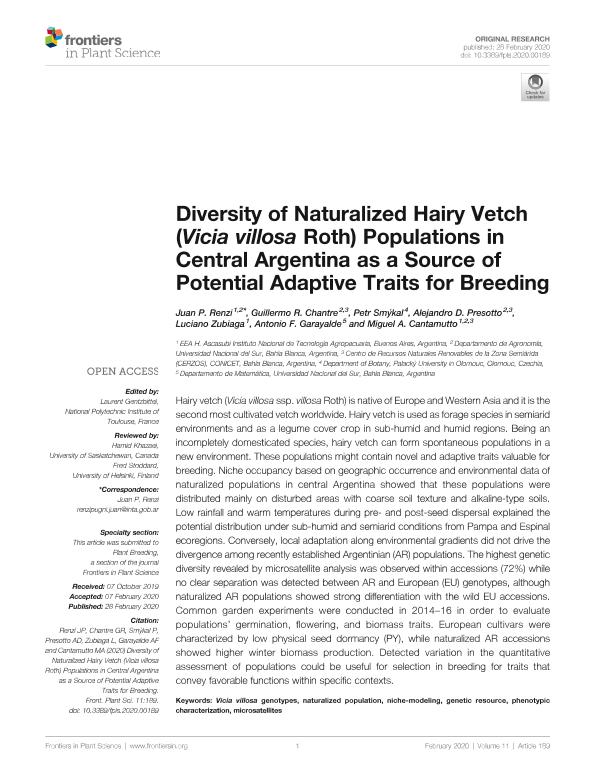Artículo
Diversity of naturalized hairy vetch (Vicia villosa Roth) populations in central Argentina as a source of potential adaptive traits for breeding
Renzi, Juan Pablo; Chantre Balacca, Guillermo Ruben ; Smýkal, Petr; Presotto, Alejandro Daniel
; Smýkal, Petr; Presotto, Alejandro Daniel ; Zubiaga, Luciano
; Zubiaga, Luciano ; Garayalde, Antonio Francisco
; Garayalde, Antonio Francisco ; Cantamutto, Miguel Ángel
; Cantamutto, Miguel Ángel
 ; Smýkal, Petr; Presotto, Alejandro Daniel
; Smýkal, Petr; Presotto, Alejandro Daniel ; Zubiaga, Luciano
; Zubiaga, Luciano ; Garayalde, Antonio Francisco
; Garayalde, Antonio Francisco ; Cantamutto, Miguel Ángel
; Cantamutto, Miguel Ángel
Fecha de publicación:
02/2020
Editorial:
Frontiers Media S.A.
Revista:
Frontiers in Plant Science
ISSN:
1664-462X
Idioma:
Inglés
Tipo de recurso:
Artículo publicado
Clasificación temática:
Resumen
Hairy vetch (Vicia villosa ssp. villosa Roth) is native of Europe and Western Asia and it is the second most cultivated vetch worldwide. Hairy vetch is used as forage species in semiarid environments and as a legume cover crop in sub-humid and humid regions. Being an incompletely domesticated species, hairy vetch can form spontaneous populations in a new environment. These populations might contain novel and adaptive traits valuable for breeding. Niche occupancy based on geographic occurrence and environmental data of naturalized populations in central Argentina showed that these populations were distributed mainly on disturbed areas with coarse soil texture and alkaline-type soils. Low rainfall and warm temperatures during pre- and post-seed dispersal explained the potential distribution under sub-humid and semiarid conditions from Pampa and Espinal ecoregions. Conversely, local adaptation along environmental gradients did not drive the divergence among recently established Argentinian (AR) populations. The highest genetic diversity revealed by microsatellite analysis was observed within accessions (72%) while no clear separation was detected between AR and European (EU) genotypes, although naturalized AR populations showed strong differentiation with the wild EU accessions. Common garden experiments were conducted in 2014-16 in order to evaluate populations? germination, flowering and biomass traits. European cultivars were characterized by low physical seed dormancy (PY), while naturalized AR accessions showed higher winter biomass production. Detected variation in the quantitative assessment of populations could be useful for selection in breeding for traits that convey favourable functions within specific contexts.
Archivos asociados
Licencia
Identificadores
Colecciones
Articulos(CERZOS)
Articulos de CENTRO REC.NAT.RENOVABLES DE ZONA SEMIARIDA(I)
Articulos de CENTRO REC.NAT.RENOVABLES DE ZONA SEMIARIDA(I)
Citación
Renzi, Juan Pablo; Chantre Balacca, Guillermo Ruben; Smýkal, Petr; Presotto, Alejandro Daniel; Zubiaga, Luciano; et al.; Diversity of naturalized hairy vetch (Vicia villosa Roth) populations in central Argentina as a source of potential adaptive traits for breeding; Frontiers Media S.A.; Frontiers in Plant Science; 11; 189; 2-2020
Compartir
Altmétricas



